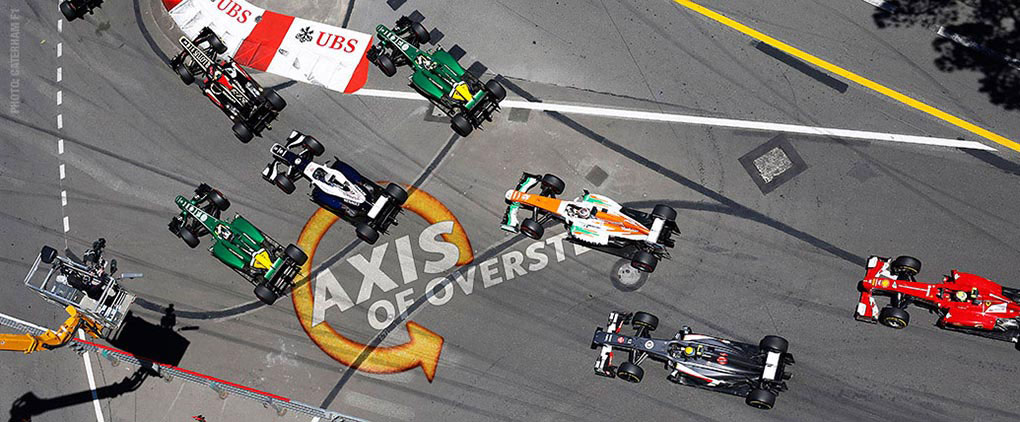While I agree with Lotus F1 principal Eric Boullier that it's "weird to change the length of a football pitch at half time to accommodate players who can't run as fast", there are less explored aspects of current tire performance trends that reach beyond F1 into feeder series and will have a potential effect on future racers.
Filippo Zanier has worked in motor sport as a reporter and as Series Coordinator and PR Manager for AutoGP World Series and for the Gulf 12 Hours at Yas Marina. He has been a frequent commenter here and has recently started The Outside Pass. We are very happy to have Filippo contribute to Axis of Oversteer.
GP3 Getting Tyred Too by Filippo Zanier
 While the delamination issues suffered between Bahrain and Catalunya forced Pirelli to admit that there may be something wrong with their tyre construction, in Spain we assisted to another race weekend dominated by rubber.
While the delamination issues suffered between Bahrain and Catalunya forced Pirelli to admit that there may be something wrong with their tyre construction, in Spain we assisted to another race weekend dominated by rubber.Engineer-to-driver radio messages were a litany of tyre saving advices, whilst those from drivers to the pit walls where a string of tyre-related yelling. Even Alonso’s win, despite an evident advantage in performance/wear balance, was in jeopardy before the last pit-stop due to a delamination hint that was spotted just in time by the Ferrari crew.
Neither fun nor exciting if you ask me, and getting worse one GP after the other, which is what should really worry both paddock and fans.
But what’s even more worrying is the effect that this new joint FIA/Pirelli approach to motor racing is having on the feeder championships, namely GP3.
Barcelona saw the debut of the new car, with improved aero and a 400 bhp V6 engine, a big step forward compared to last year’s turbo powerplant. The performance gain was sensible and in winter testing, with cold track temperatures, drivers were amazed. Anyway, May is considerably hotter and in Barcelona the attention quickly switched to worries concerning tyre wear.
The races, Saturday’s one in particular, proved that the issue was real: Arden’s rising star Daniil Kyvat dropped to P20 after running as high as 4th and his team mate Sainz Jr crossed the line in 15th. Art’s Facu Regalia posted a good sixth time in Quali, but in the race he had to retire with two laps to go after losing a large chunk of tread from his left front, the tyre which has to cope with a tremendous stress in Turn 9, the infamous Campsa corner (see the image opening the post).
Things went a bit better in Race 2, mainly because drivers were well aware of the problem and nursed their rubber to the line, but at the end of the weekend everybody agreed that the situation was far from ideal, and that pushing for more than a few laps would have ended in tyres falling to pieces.
So what’s happening? As F1 has turned racing into tyre management, its feeder championships are doing the same. GP2 went on that path two years ago and they’re holding the line, and now it’s GP3′s turn.
But is that the right thing to do? The average age of the GP3 field is 19 years old, and most drivers have F.Renault 2.0, F3 or the old spec GP3 as a background, so they are tackling their first season on high-powered machinery: is tyre management what they should really worry about?
GP3 already offers very little track time (45 mins. Practice, 30 mins. Quali, 2 Races of 30 mins. each) wouldn’t it be better if drivers could just be allowed to show their talent and outright speed, their consistency and focus, their ability to push from the lights to the flag? These young guns still have a lot to prove, forcing them to drive slower to preserve the tyres means diverting the attention from what should really matter at their age.
In the next few years, when they’ll graduate to GP2, they’ll have plenty of time to get frustrated because of tyres but for now, please, just let them race.



I believe a more apt analogy would be "why is Pirelli changing the length of the football field every season?" It's clear tires are picking winners and losers, when it should instead be about equalizing or balancing element to bring the racing closer together...it's original intent. Let's have the racing be about tires also but not leave out the RACING bit.
ReplyDeleteFrom a resource standpoint -- which F1 is paying at leaste lip service to -- it's ridiculously wasteful to have 3- and 4- lap tires. I'd much rather see harder compounds and slower racing, at least at first. Teams will figure out ways to find more grip via telemetry and other advances. You can see that soft compounds arent capable of handling the power now anyway.
ReplyDeleteHappy to be part of the Axis family :)
ReplyDeleteThe situation with tyres this year is so compromised that more or less any complain I read had at least a point. Still, I believe that what's happening is quite unfair. A couple of teams are coping with the given rubber better than others, and it's not by luck. They simply did a better job with the same kind of information. I don't remember Red Bull complaining in 2011 when they won the Turkish GP with a four stopper...
Anyway, as I wrote in my post, I'm more worried about the effect that this approach is having on feeder formulae. I spoke with some of the drivers after Barcelona and they are quite gutted, trying hard for a couple of laps means kissing performance goodbye. They really don't need that...